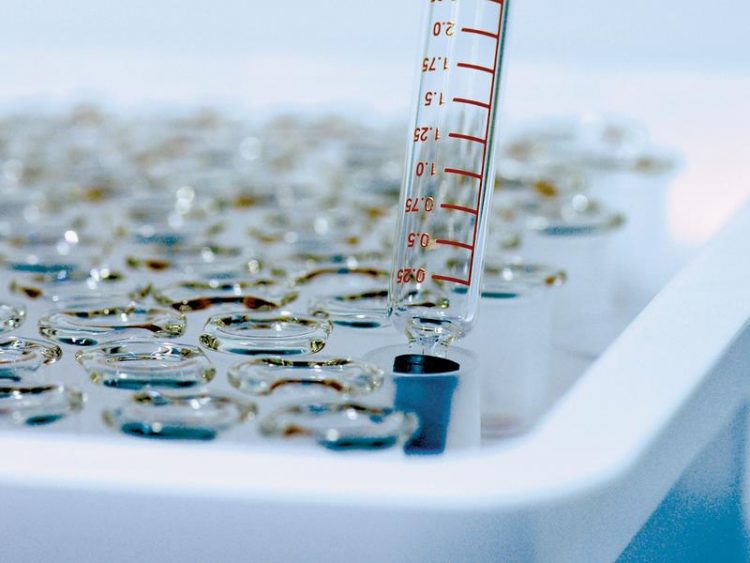Inactivate vaccines faster and more effectively using electron beams

Fraunhofer FEP
Scientists at Fraunhofer FEP in conjunction with other partners within the Fraunhofer Gesellschaft have been conducting research for several years on employing electron-beam technology in medical engineering.
Low-energy inactivation of pathogens by means of electron beams (LEEI – Low-Energy Electron Irradiation) can also be used for faster manufacture of more effective vaccines. The foundation for this has been under joint development by the Fraunhofer FEP, IZI, IPA, and IGB Institutes since 2014.
Most vaccinations are based on inactivated vaccines, i.e. vaccines containing viruses that are inhibited from further reproduction. The pathogens can then no longer cause disease in patients. Nevertheless, the immune system still detects them and forms the corresponding antibodies to provide effective protection. Usually the pathogens must be kept in a chemical for several days until they are inactivated.
Formaldehyde, for example, needs approximately two weeks in order to neutralize hepatitis A viruses. This expenditure of time is costly and a disadvantage for industry. In addition, formaldehyde attacks the viruses' proteins that the immune system forms the antibodies to. Formaldehyde thus alters the viruses, thereby reducing the actual effectiveness of the vaccine.
The Fraunhofer consortium is very experience in the development of new technologies that use low-energy electron beams. The results of the project have established that the technology is fundamentally viable for a wide range of viruses, such as influenza and Porcine Reproductive and Respiratory Syndrome virus/PRRSV that triggers this syndrome in swine, as well as other types of pathogens like bacteria and parasites. The genetic substance necessary for the viruses to self-replicate is destroyed by the irradiation.
However, the surface characteristics of the virus important for the immune system response are retained by LEEI, in contrast to chemical inactivation using toxins like formaldehyde. This allows the body to form antibodies having greater specificity for the pathogen, which provides improved protection. As a result, lower vaccination doses might be able to be employed.
Moreover, just a few milliseconds are sufficient to inactivate the viruses or bacteria thanks to this technology, instead of several days or even weeks. An additional advantage of irradiation using low-energy electrons is that it can be carried out in any laboratory.
“A novel, compact, and highly efficient technology has been developed for producing vaccines by utilizing low-energy electron beams that is more effective as well as more economical,” explains Dr. Jessy Schönfelder, head of the medical applications group at Fraunhofer FEP, about her expectations of the development work.
Innovative medical products can likewise be sterilized effectively by low-energy electrons. Artificial knee joints with integrated electronics for monitoring deterioration are conceivable for example, or implants like cardiac valves with novel combinations of materials including biological tissue that need to be sterilized before their insertion.
The scientists of Fraunhofer FEP look forward to new projects with partners from industry in order to help suitably adapt this pioneering technology to further applications. That could involve the development of a product-specific, transportable mini-sterilizer, or of technologies for sterilization of liquid products.
Media Contact
More Information:
http://www.fep.fraunhofer.de/All latest news from the category: Life Sciences and Chemistry
Articles and reports from the Life Sciences and chemistry area deal with applied and basic research into modern biology, chemistry and human medicine.
Valuable information can be found on a range of life sciences fields including bacteriology, biochemistry, bionics, bioinformatics, biophysics, biotechnology, genetics, geobotany, human biology, marine biology, microbiology, molecular biology, cellular biology, zoology, bioinorganic chemistry, microchemistry and environmental chemistry.
Newest articles

Bringing bio-inspired robots to life
Nebraska researcher Eric Markvicka gets NSF CAREER Award to pursue manufacture of novel materials for soft robotics and stretchable electronics. Engineers are increasingly eager to develop robots that mimic the…

Bella moths use poison to attract mates
Scientists are closer to finding out how. Pyrrolizidine alkaloids are as bitter and toxic as they are hard to pronounce. They’re produced by several different types of plants and are…

AI tool creates ‘synthetic’ images of cells
…for enhanced microscopy analysis. Observing individual cells through microscopes can reveal a range of important cell biological phenomena that frequently play a role in human diseases, but the process of…





















